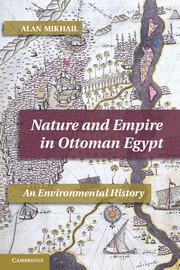Book contents
- Frontmatter
- Contents
- Maps
- Figures
- Tables
- Note on Transliteration and Dates
- Abbreviations
- Acknowledgments
- Map 1 Egypt and the Ottoman Empire
- Map 2 Lower Egypt (Nile Delta)
- Map 3 Middle Egypt
- Map 4 Upper Egypt
- Map 5 Cairo and Surroundings, 1801
- Introduction: Empire by Nature
- 1 Watering the Earth
- 2 The Food Chain
- 3 The Framework of Empire
- 4 In Working Order
- 5 From Nature to Disease
- 6 Another Nile
- Conclusion: The Imagination and Reality of Public Works
- Appendix: Citations for Cases Included in Tables 2.1–2.4
- Bibliography
- Index
- Titles in the series
4 - In Working Order
Published online by Cambridge University Press: 03 May 2011
- Frontmatter
- Contents
- Maps
- Figures
- Tables
- Note on Transliteration and Dates
- Abbreviations
- Acknowledgments
- Map 1 Egypt and the Ottoman Empire
- Map 2 Lower Egypt (Nile Delta)
- Map 3 Middle Egypt
- Map 4 Upper Egypt
- Map 5 Cairo and Surroundings, 1801
- Introduction: Empire by Nature
- 1 Watering the Earth
- 2 The Food Chain
- 3 The Framework of Empire
- 4 In Working Order
- 5 From Nature to Disease
- 6 Another Nile
- Conclusion: The Imagination and Reality of Public Works
- Appendix: Citations for Cases Included in Tables 2.1–2.4
- Bibliography
- Index
- Titles in the series
Summary
The foregoing chapters sketch a system of natural resource balance, management, and movement across the Ottoman Empire that emphasizes the centrality of grains and wood. This was a massively complex system built around irrigation and coordinated through the extreme localism of Egyptian peasant knowledge and experience as filtered through the administration of an Ottoman imperial system of rule. The motor force that powered the entire system was the caloric energy output of human and animal labor. For the Ottoman bureaucracy of Egypt, labor was the answer to the question of how best to maximize and marshal the cultivation potentials of the Egyptian countryside. As I argue in this chapter, shifts in labor on irrigation works and other construction projects over the course of the long eighteenth century ushered in new conceptions of the Ottoman state, of the Egyptian social body, and of the relationship between the two. The single most important factor affecting this transition in the forms and practices of labor over the period was an increase in the relative size of repair projects to irrigation works and other structures at the beginning of the nineteenth century as compared to the end of the seventeenth. Irrigation works became larger over the course of the long eighteenth century to keep up with increases in the demand for irrigated land and agricultural production necessitated by Egypt's move toward a centralized bureaucracy disconnected from the rest of the Ottoman imperial system.
- Type
- Chapter
- Information
- Nature and Empire in Ottoman EgyptAn Environmental History, pp. 170 - 200Publisher: Cambridge University PressPrint publication year: 2011

